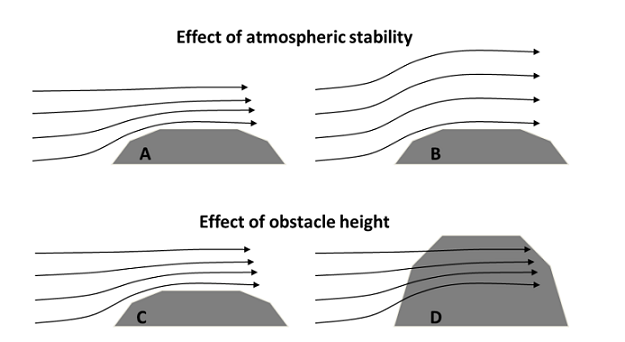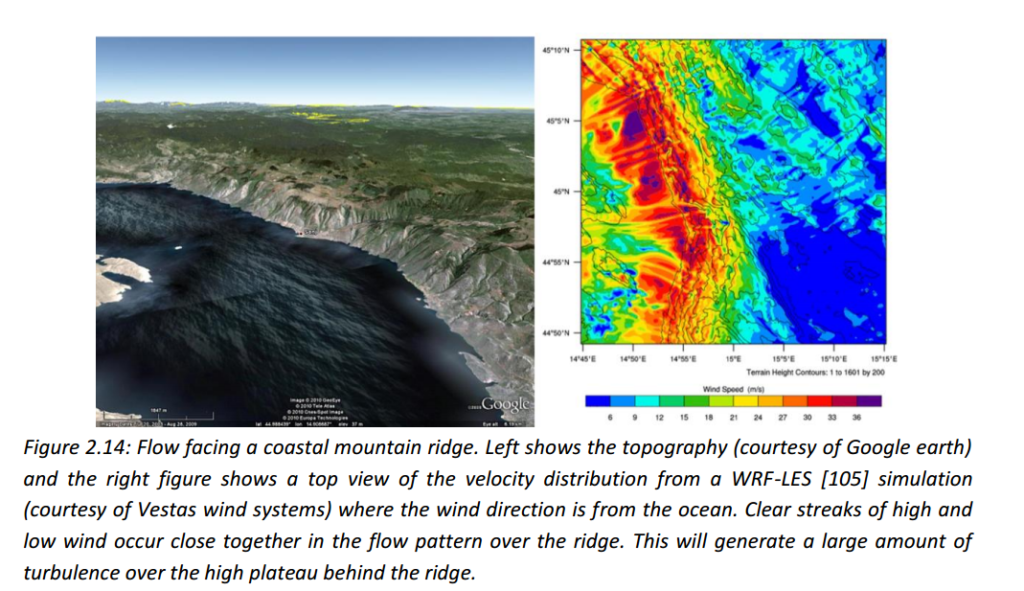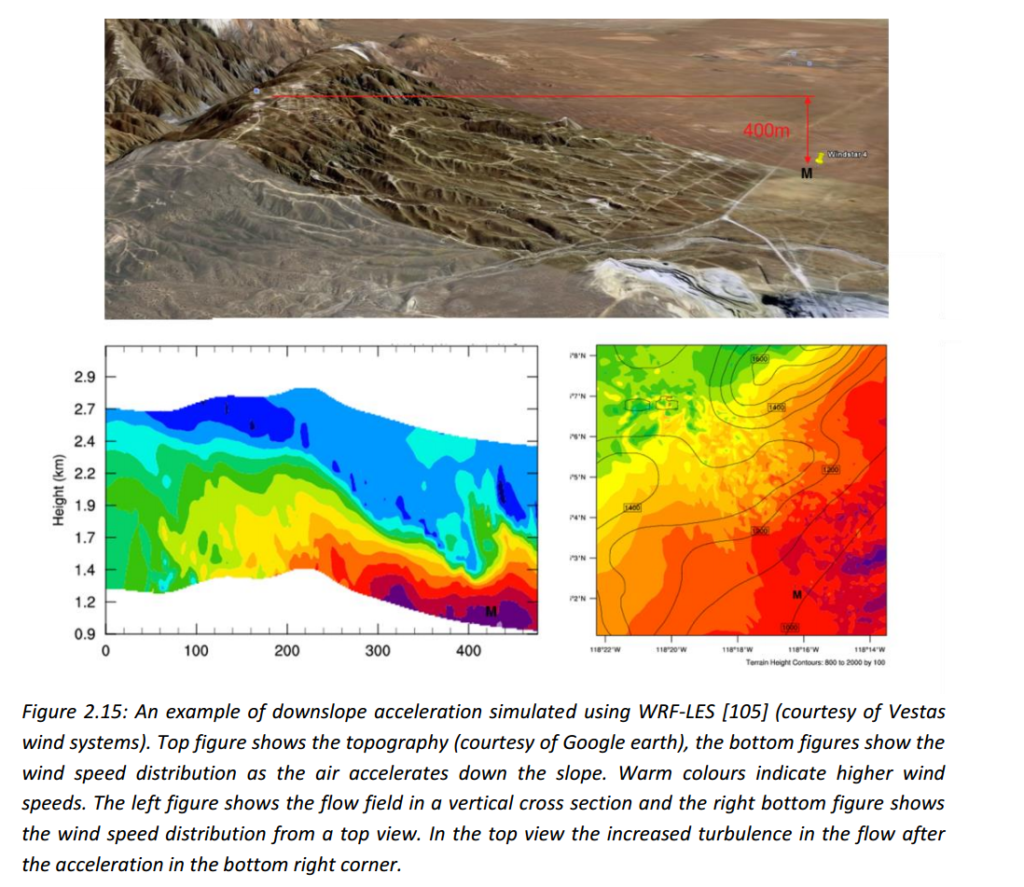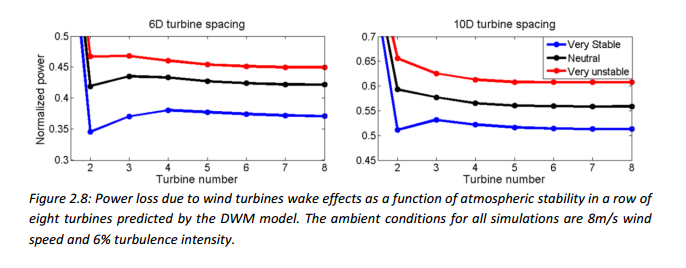Atmospheric stability is related to the temperature distribution with height, which has an important effect for the turbulence in the atmosphere due to buoyancy effects. The main impact of atmospheric stability with respect to wind energy, is that atmospheric stability amplifies or dampens turbulent fluctuations depending on the state of the air mass. As a consequence, the properties of the flow filed changes. The most noticeable effects are changes in turbulence, wind veer and wind shear, as well as the behaviour of the flow field over terrain and obstacles. These parameters are very important for both the distribution of energy over the wind farm area and for the local turbine performance (the turbine performance aspect is described in a sperate topic).
Modern Energy has developed a method to include the effect of atmospheric stability numerically in the layout and yield calculations. As atmospheric stability influences the spatial distribution of the wind resource of the wind farm area, it is important to include the effect already in the wind farm design stage to avoid sub-optimal design. In short the method consist of the following steps:
- Conduct three separate CFD calculations with stable, neutral and unstable stratification in WindSim.
- Analyse field data from site measurements to find distribution of atmospheric stability.
- Create a stability weighted wind resource map. This is done by combining the three CFD flow fields at different atmospheric stability, weighted by their relative fraction of occurrence at the studies site.
Below is a short description of atmospheric stability and its effect related to wind farm design.
Atmospheric stability
Atmospheric stability is related to the temperature distribution with height, which has an important effect for the turbulence in the atmosphere due to buoyancy effects. In a stable atmosphere the buoyancy effects suppress vertical fluctuations of the air, and in an unstable atmosphere the vertical fluctuations are enhanced. The neutral condition, in which buoyancy effects are negligible, are only experienced a fraction of the time in the atmosphere (Sathe et al. [71]). The stability of the atmosphere is dictated by the direction of the vertical heat flux. The transfer of heat from the surface upwards to the air leads to an unstable ABL, and when the heat flux is directed downwards the air becomes stratified and the ABL stable. In simple terms, this can be expressed as when the surface is warmer than the air an unstable atmosphere will develop and when the surface is cooler the ABL will be stable (Stull [72]).
Not only the temperature gradient is important for atmospheric stability. At high wind speeds the mechanically generated turbulence often dominates the flow and the stability approaches near neutral conditions. The Monin-Obukhov (M-O) length is the most commonly used quantity to characterise the atmospheric stability. The M-O length can be described as the height of a sub-layer where the mechanically driven turbulence due to ABL shear is more important than the buoyancy driven turbulence. This means that a large M-O number corresponds to near neutral conditions. The sign of the M-O length indicates whether the atmosphere is stable (positive) or unstable (negative). For more details see Obukhov [73] and Monin and Obukhov [74]. The physical effect due to non-neutral atmosphere is to enhance (unstable atmosphere) or dampen (stable atmosphere) the vertical turbulent fluctuations due to buoyancy effects. This in turn influences the turbulence intensity, the vertical shear of the ABL (Kirchhoff and Kaminsky [75], Irvin et al. [76], Zoumakis [77]) and the length scale of the ABL turbulence (Peña et al. [44], Sathe et al. [71] and Stull [72]).
Atmospheric stability and flow over terrain & obstacles
Atmospheric stability determines the flow pattern over an obstacle, whether the air flows over or around the hill and also the speed-up over the hill. It is also the reason for many interesting phenomena like low-level-jets, hydraulic jumps, mountain waves, downslope winds, internal boundary layers and vortex rolls. As shown further down this page it also affects wake loss, not only through different turbulent intensity but also different turbulent length scales.

![]()


Atmospheric stability and wakes
The effect of atmospheric stability on wake evolution, turbine loads and power production has become an increasingly researched field in academia. A number of studies has documented that there is an influence by the atmospheric stability on turbine loads and power production; this is observed both in measurements (Barthelmie et al. [22], Barthelmie et al. [78], Wharton et al. [79], Schepers et al. [46] and Hansen et al. [49]) and by simulations (Larsen et al. [50], Sathe et al. [71], Churchfield et al. [80], Lee et al. [81] and Lavely et al. [82]). So far, however, few experiments conducted have been designed in such a way that it is possible to separate the effect of atmospheric stability from turbulence intensity. Keck et al. [45] isolated the effect of atmospheric stability by conducting a series of numerical simulations where the atmospheric stratification was varied, but the turbulence intensity level was maintained constant. The results showed that the effect of atmospheric stability requires a more thorough treatment than the standard approach of altering the ambient turbulence intensity levels, and that atmospheric stability influences the wake dynamics even when the turbulence intensity level is kept constant, see figure 2.8 (and figure 5.10). This effect on the wake dynamics stems from the effect of atmospheric stability on the characteristic turbulence length scale of the ABL. According to the fundamental idea of a split in scales, a change in turbulent length scale should modify the distribution of turbulent energy between the wake meandering and the wake deficit evolution for a given turbulence intensity level.

References
- All references refer to reference list in http://orbit.dtu.dk/files/59206216/A_consistent_turbulence_formulation.pdf (page 216-218)
